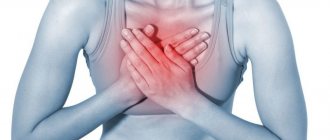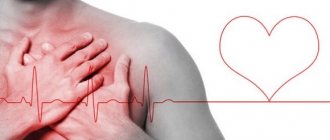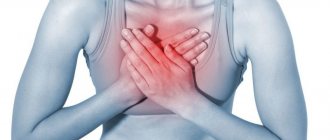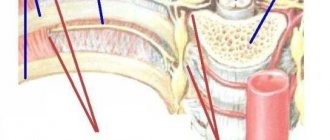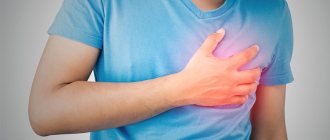Chest pain can occur due to various diseases; it is sometimes difficult even for a doctor to understand it right away, so patients with such complaints usually undergo additional examination. Chest pain can manifest as diseases of the heart, respiratory system, gastrointestinal tract, spine, mediastinum, and central nervous system. All human internal organs are innervated by the autonomic nervous system, the trunks of which arise from the spinal cord. When approaching the chest, the nerve trunk gives off branches to individual organs. That is why sometimes pain in the stomach can be felt like pain in the heart - they are simply transmitted to the common trunk, and from it to another organ. Moreover, the spinal nerve roots contain sensory nerves that innervate the musculoskeletal system. The fibers of these nerves are intertwined with the fibers of the nerves of the autonomic nervous system, and therefore a completely healthy heart can respond with pain in various diseases of the spine.
Finally, chest pain may depend on the state of the central nervous system: with constant stress and high neuropsychic stress, a malfunction occurs in its functioning - neurosis, which can also manifest itself as pain in the chest.
Some chest pains are unpleasant, but not life-threatening, but there are chest pains that need to be relieved immediately - a person’s life depends on it. In order to figure out how dangerous chest pain is, you need to see a doctor. Perhaps this will save your life or calm you down if no serious problems with your health are found.
Causes of chest pain
- Heartburn. Acidic stomach acid that flows from the stomach into the esophagus (the tube that connects the mouth to the stomach) can cause heartburn, a painful burning sensation in the chest. It is often combined with a sour taste and belching. Heartburn chest pain is usually associated with food intake and can last for hours. This symptom most often occurs when bending or lying down. Taking antacids relieves heartburn.
- Panic attacks. If you experience attacks of unreasonable fear, combined with chest pain, rapid heartbeat, hyperventilation (rapid breathing) and profuse sweating, you may be suffering from “panic attacks” - a unique form of dysfunction of the autonomic nervous system.
- Pleurisy. Sharp, localized chest pain that gets worse when you inhale or cough may be a sign of pleurisy. The pain occurs due to inflammation of the membrane lining the inside of the chest cavity and covering the lungs. Pleurisy can occur with various diseases, but most often with pneumonia.
- Tietze syndrome. Under certain conditions, the cartilaginous parts of the ribs, especially the cartilage that attaches to the sternum, can become inflamed. Pain in this disease can occur suddenly and be quite intense, simulating an attack of angina. However, the location of pain may vary. With Tietze syndrome, pain may increase when pressure is placed on the sternum or ribs near the sternum. Pain during angina pectoris and myocardial infarction does not depend on this.
Osteochondrosis of the cervical and thoracic spine leads to so-called vertebrogenic cardialgia, which resembles angina pectoris. In this condition, there is intense and prolonged pain behind the sternum, in the left half of the chest. There may be irradiation into the arms and interscapular area. The pain increases or decreases with changes in body position, head turns, and arm movements. The diagnosis can be confirmed by performing an MRI of the spine. Magnetic resonance imaging of the spine will help determine the cause of pain in the chest if it is caused by pinched nerve roots or the presence of herniated intervertebral discs.
- Pulmonary embolism. This type of embolism occurs when a blood clot enters the pulmonary artery, blocking the flow of blood to the heart. Symptoms of this life-threatening condition may include sudden, sharp chest pain that occurs or gets worse with deep breathing or coughing. Other symptoms are shortness of breath, palpitations, anxiety, loss of consciousness.
- Other lung diseases. Pneumothorax (collapsed lung), high pressure in the blood vessels supplying the lungs (pulmonary hypertension), and severe asthma may also cause chest pain.
- Muscle diseases. Pain caused by muscle diseases usually begins to bother you when you turn your body or raise your arms. Chronic pain syndrome such as fibromyalgia. May cause persistent chest pain.
- Damage to ribs and pinched nerves. Bruises and fractures of the ribs, as well as pinched nerve roots, can cause pain, sometimes very severe. With intercostal neuralgia, pain is localized along the intercostal spaces and intensifies with palpation.
- Diseases of the esophagus. Some diseases of the esophagus can cause difficulty swallowing and therefore chest discomfort. Esophageal spasm can cause chest pain. In patients with this disease, the muscles that normally move food down the esophagus work uncoordinated. Since esophageal spasm can resolve after taking nitroglycerin - just like angina - diagnostic errors often occur. Another swallowing disorder known as achalasia can also cause chest pain. In this case, the valve in the lower third of the esophagus does not open as it should and does not allow food to pass into the stomach. It remains in the esophagus, causing discomfort, pain and heartburn.
- Shingles. This infection, caused by the herpes virus and affecting the nerve endings, can cause severe chest pain. The pain can be localized in the left half of the chest or be of a girdling nature. This disease can leave behind a complication - postherpetic neuralgia - the cause of prolonged pain and increased skin sensitivity.
- Diseases of the gallbladder and pancreas. Gallstones or inflammation of the gallbladder (cholecystitis) and pancreas (pancreatitis) can cause pain in the upper abdomen that radiates to the heart.
- Myocardial infarction - a blood clot that blocks the movement of blood in the arteries of the heart can cause pressing, squeezing chest pain that lasts more than a few minutes. The pain can radiate to the back, neck, lower jaw, shoulders and arms (especially the left). Other symptoms may include shortness of breath, cold sweats, and nausea.
- Angina pectoris. Over the years, fatty plaques can form in the arteries of your heart, limiting the flow of blood to the heart muscle, especially during exercise. It is the restriction of blood flow through the arteries of the heart that causes attacks of chest pain - angina. Angina is often described by people as a feeling of tightness or tightness in the chest. It usually occurs during physical activity or stress. The pain usually lasts about a minute and goes away with rest.
- Other causes of chest pain include inflammation of the lining of the heart (pericarditis), most often due to a viral infection. Pain with pericarditis is most often acute, stabbing in nature. Fever and malaise may also occur. Less commonly, the pain may be caused by a dissection of the aorta, the main artery in your body. The inner layer of this artery can separate under blood pressure and the result is sharp, sudden and severe pain in the chest. Aortic dissection can be the result of chest trauma or a complication of uncontrolled hypertension.
Because chest pain can have many different causes, do not self-diagnose, self-medicate, or ignore severe or prolonged pain. The cause of your pain may not be so serious - but in order to establish it, you need to contact a specialist.
What to do before the ambulance arrives?
If myocardial infarction or pulmonary embolism develops, proper treatment can only be carried out in a hospital setting.
Even before the ambulance arrives, you should:
- Take one tablet of aspirin, nitroglycerin. Aspirin reduces blood clotting, nitroglycerin improves blood supply to the myocardium.
- Make breathing as easy as possible. It is important to provide fresh air. To do this, you need to open a window in the room and remove clothes that are constricting your chest, for example, unbutton the buttons of a shirt.
- Take a comfortable position. A semi-sitting pose can make breathing easier, which you can take by placing several pillows under your head and shoulders. Another option is a sitting position with your elbows resting on your knees or a table with your torso slightly tilted forward. (Fig. 4).
- Try to calm down and not panic. During stress, the heart rate, respiratory movements and the heart's need for oxygen increase. All this aggravates the course of myocardial infarction and pulmonary embolism and worsens the prognosis.
Figure 4. Poses that make breathing easier. Source: MedPortal
Chest pain caused by changes in the central nervous system
Chest pain can also occur with other diseases. One of the most common diseases that causes frequent and prolonged pain in the chest is cardioneurosis, which develops against the background of a temporary functional disorder of the central nervous system. Neuroses are the body’s response to various mental shocks (intense, short-term or less intense, but long-lasting).
Pain due to cardioneurosis can have a different character, but most often it is constant, aching and is felt in the area of the apex of the heart (in the lower part of the left half of the chest). Sometimes pain due to cardioneurosis may resemble pain due to angina pectoris (short-term acute), but taking nitroglycerin does not relieve it. Often attacks of pain are accompanied by reactions from the autonomic nervous system in the form of facial flushing, moderate heartbeat, and a slight increase in blood pressure. With cardioneurosis, other signs of neuroses are almost always present - increased anxiety, irritable weakness, etc. Helps with cardioneurosis are the elimination of traumatic circumstances, the correct daily routine, sedatives, and for sleep disorders - sleeping pills.
Sometimes cardioneurosis is difficult to distinguish from coronary heart disease (CHD); the diagnosis is usually made based on careful observation of the patient, since there may be no changes on the ECG in either case.
A similar picture can be caused by changes in the heart during menopause. These disorders are caused by changes in hormonal levels, resulting in neurosis and metabolic disorders in the heart muscle (menopausal myocardiopathy). Pain in the heart is combined with the characteristic manifestations of menopause: flushing of the face, bouts of sweating, chills and various sensory disturbances in the form of “goosebumps”, insensitivity of certain areas of the skin, etc. Just as with cardioneurosis, heart pain is not relieved by nitroglycerin; sedatives and hormone replacement therapy help.
When is immediate medical help required?
- The pain is very severe; in addition, the patient suffers from shortness of breath, fever, and cough.
- Pain that is localized in the area of the appendix, lungs or stomach radiates to the back.
- The pain is constant, it does not go away and intensifies during movements.
When you need a doctor's help
If you want to learn in more detail how to treat back pain when coughing, and also consider alternative treatment methods, you can read an article about this on our portal.
Chest pain due to diseases of the spine and ribs
Chest pain, very similar to heart pain, can occur with various diseases of the spine, for example, with osteochondrosis, herniated discs, ankylosing spondylitis, etc. Osteochondrosis is dystrophic (metabolic) changes in the spine. As a result of poor nutrition or high physical activity, bone and cartilage tissue, as well as special elastic pads between individual vertebrae (intervertebral discs), are gradually destroyed. Such changes cause compression of the spinal nerve roots, which causes pain. If changes occur in the thoracic spine, the pain may be similar to pain in the heart or pain in the gastrointestinal tract. The pain can be constant or in the form of attacks, but it always intensifies with sudden movements. Such pain cannot be relieved with nitroglycerin or antispasmodics; it can only be relieved by painkillers or heat. Pain in the chest area can occur when a rib is fractured. These pains are associated with injury and intensify with deep breathing and movement.
Tips for emergency pain relief. First aid
- First you need to go to bed. It is important that the sleeping place is equipped with a firm mattress. The position should be such that pain is minimal.
- You can apply a cold compress to the injured area to relieve pain. This will reduce inflammation.
- You can gently massage your back using an ice bag.
Ice bag - Sometimes the use of warming ointments (for example, made from snake or bee venom) is allowed.
- Finally, you can give the patient two tablets of No-Shpa or another painkiller. Swelling can be eliminated with diuretic tea or a diuretic - this will reduce compression of the nerves.
"No-Shpa"
Chest pain due to lung diseases
The lungs occupy a significant part of the chest. Chest pain can occur against the background of inflammatory diseases of the lungs, pleura, bronchi and trachea, with various injuries to the lungs and pleura, tumors and other diseases.
Chest pain occurs especially often when there is a disease of the pleura (the serous sac that covers the lungs and consists of two layers, between which the pleural cavity is located). With inflammation of the pleura, pain is usually associated with coughing, deep breathing and accompanied by fever. Sometimes such pain can be confused with heart pain, for example, with pain due to pericarditis. Very severe chest pain occurs when lung cancer grows in the pleural area.
In some cases, air (pneumothorax) or fluid (hydrothorax) enters the pleural cavity. This can happen with a lung abscess, pulmonary tuberculosis, etc. With spontaneous (spontaneous) pneumothorax, sharp sudden pain appears, shortness of breath, cyanosis, and blood pressure decreases. The patient has difficulty breathing and moving. The air irritates the pleura, causing severe stabbing pain in the chest (in the side, on the affected side), radiating to the neck, upper limb, and sometimes to the upper abdomen. The patient's chest volume increases and the intercostal spaces widen. Help for such a patient can only be provided in a hospital.
Summing up
If you cannot breathe freely due to back pain, then act immediately - do not delay visiting a doctor! This symptom may indicate the development of a number of dangerous diseases, and therefore the time during which you try to eliminate the pain yourself and use traditional medicine will be wasted. It’s better to see a doctor - he will rule out cancer and pneumonia, determine the cause of the symptom and prescribe adequate treatment.

